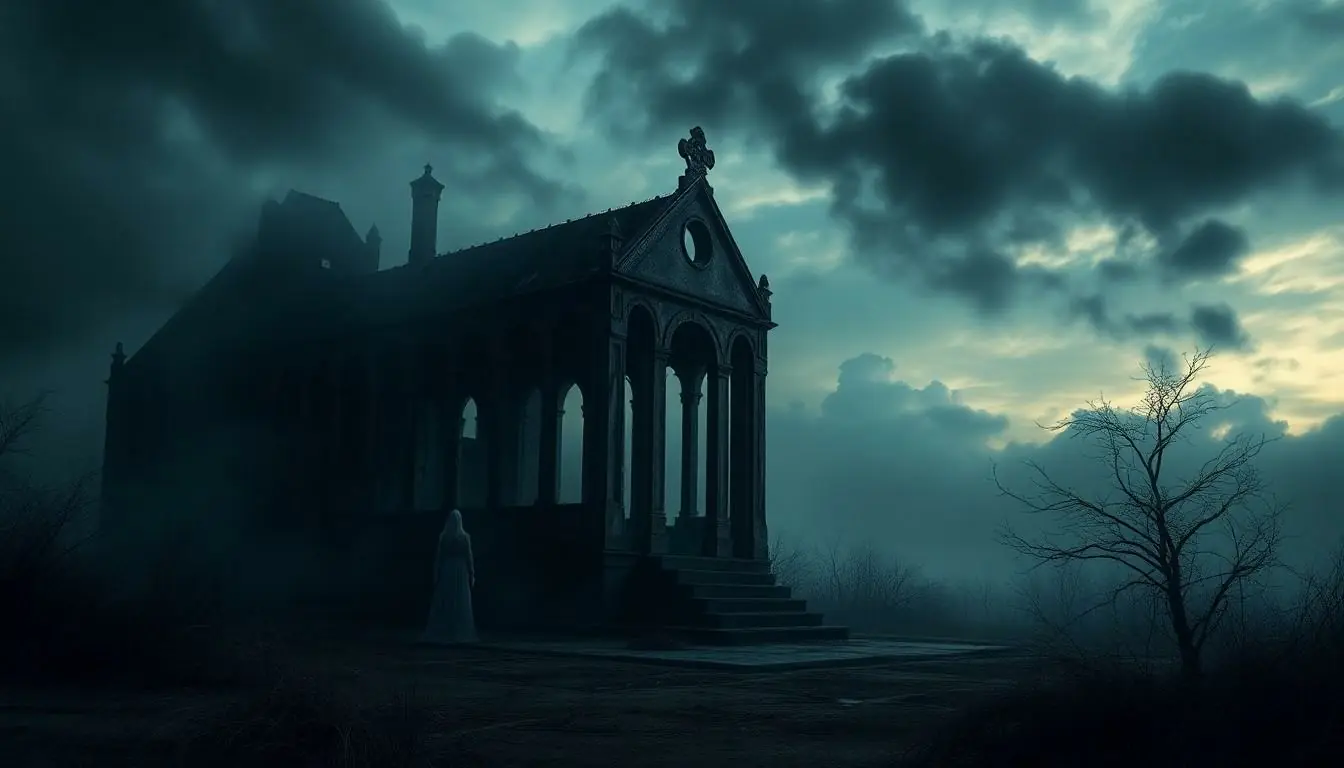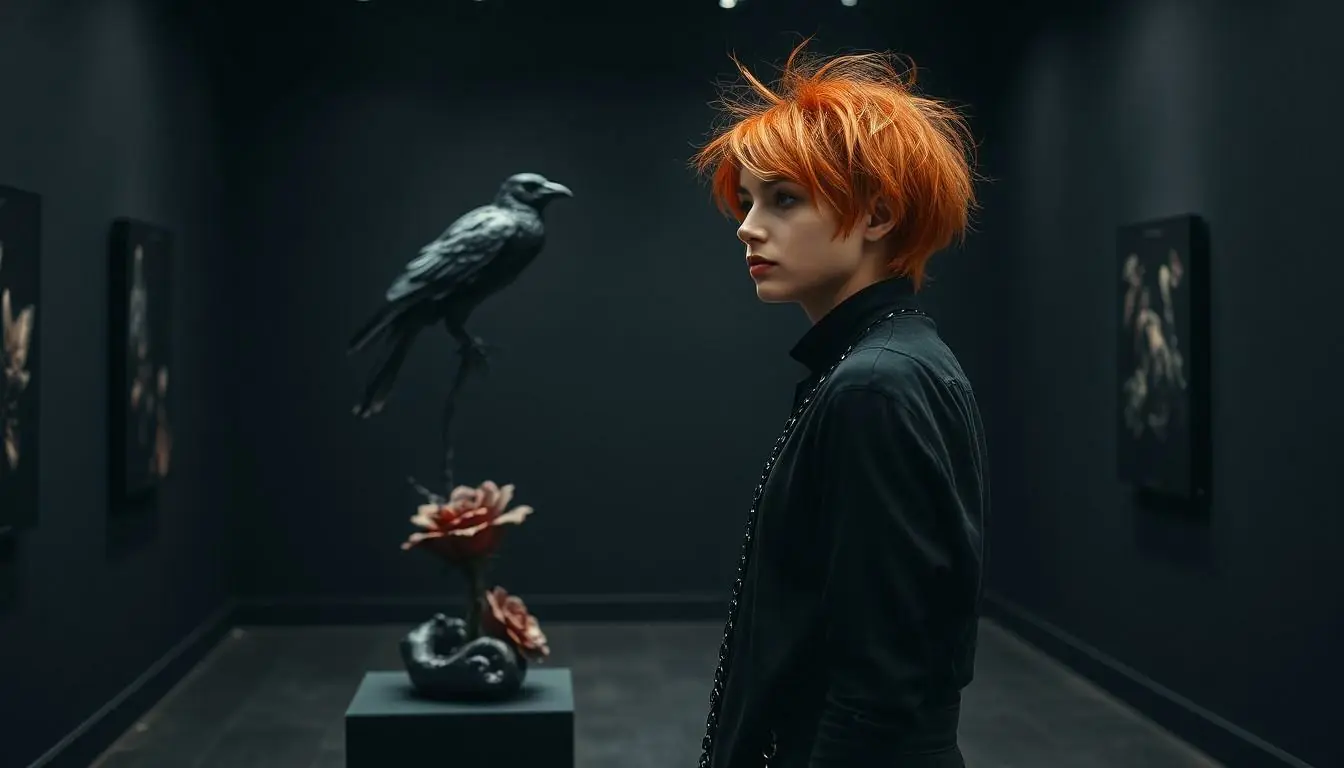Table of Contents
ToggleIn a world where art often dances between the whimsical and the mundane, modern gothic art emerges like a raven in a field of daisies. With its dark themes and haunting beauty, this genre captures the imagination and invites viewers to explore the shadows lurking just beneath the surface. It’s not just about black lace and candlelight; it’s a vibrant movement that challenges conventions and embraces the eccentric.
Imagine stepping into a gallery where every piece tells a story of love, loss, and the macabre. Modern gothic art isn’t just for the brooding poet or the misunderstood artist; it speaks to anyone willing to look beyond the ordinary. So grab your favorite black turtleneck and prepare to dive into a world where the eerie meets the exquisite, and discover why this captivating style is making waves in today’s art scene.
Overview Of Modern Gothic Art
Modern gothic art combines dark themes with haunting beauty, transcending traditional gothic aesthetics. This genre captures compelling narratives of love, loss, and the macabre. Artists infuse emotion into their work, creating visual stories that resonate on multiple levels.
Many contemporary artists draw inspiration from classic gothic elements, incorporating motifs like decay, melancholy, and mystery into their creations. A notable aspect of modern gothic art is its embrace of eccentricity, reflected in the use of unconventional materials and techniques. Artists often challenge societal norms, pushing boundaries and inviting audiences to explore complex emotions.
Furthermore, the modern gothic movement thrives on digital platforms, connecting artists and enthusiasts worldwide. Social media showcases various interpretations, fostering a vibrant community. Within this context, exhibitions and galleries celebrate cutting-edge trends, amplifying the genre’s reach.
Noteworthy artists such as H.R. Giger and Yayoi Kusama exemplify the diverse expressions found within modern gothic art. While Giger’s surreal biomechanical landscapes invite viewers into nightmarish realms, Kusama’s polka-dotted infinity rooms create a sense of boundless wonder through repetition and scale. Both embrace gothic elements yet present them uniquely, demonstrating the genre’s evolution.
Exhibiting a mix of visual styles, contemporary gothic art illustrates the genre’s capacity to adapt and thrive. It captivates a broad audience, bridging the gap between traditional gothic heritage and modern artistic sensibilities. This ongoing dialogue between past and present invigorates the art world, inviting new interpretations and exploration of gothic themes.
Key Characteristics

Modern gothic art features distinctive elements that define its appeal. This genre often merges traditional gothic themes with contemporary influences, creating a unique aesthetic.
Dark Aesthetics
Dark aesthetics dominate modern gothic art. Artists utilize bold contrasts and intricate details, evoking feelings of mystery and melancholy. Shadows play an essential role, enhancing the atmosphere in pieces. Common motifs include decaying architecture, wistful landscapes, and spectral figures. Such imagery communicates a sense of otherworldliness that captivates the audience. Styles range from surreal to expressionist, emphasizing emotional intensity. Artists like H.R. Giger exemplify the mastery of this aesthetic, fusing organic forms with industrial influences. Overall, dark aesthetics create an evocative visual language that resonates in the contemporary art scene.
Symbolism And Themes
Symbolism enriches modern gothic art significantly. Themes of love, loss, and existential dread often reappear, drawing deeper connections to human experience. Roses represent beauty and fragility, while crows symbolize mystery and omens. These elements engage viewers through relatable narratives. Artists explore psychological realms, often revealing inner turmoil and societal critique. The juxtaposition of beauty and decay underscores the transient nature of existence. Additionally, technology influences themes, challenging historical concepts of gothic art. Works by Yayoi Kusama showcase how patterns and repetition reflect modern anxiety. By intertwining symbolism and themes, modern gothic art invites introspection and discussion.
Influential Artists
Modern gothic art thrives due to the contributions of various influential artists. Their diverse styles and themes resonate with the audience, pushing boundaries and expanding the genre’s reach.
Notable Contemporary Figures
Artists like H.R. Giger and Yayoi Kusama stand out within the modern gothic realm. Giger is known for his striking biomechanical imagery, blending the macabre with an otherworldly aesthetic. Kusama’s infinite dot patterns and immersive installations evoke feelings of obsession and introspection, grounding her work in existential themes. Both artists demonstrate how modern gothic art embraces traditional influences while integrating contemporary techniques. Their unique perspectives encourage dialogue and foster engagement within the art community.
Emerging Talents
Numerous emerging talents are reshaping modern gothic art. Artists such as Kiki Smith and Daria Hlazatova explore darker narratives through delicate and intricate visuals. Smith’s sculptures often reflect themes of mortality and femininity, drawing viewers into a profound emotional landscape. Hlazatova’s illustrative works combine ethereal elements with gothic motifs, creating haunting yet beautiful scenes. Each of these artists contributes fresh interpretations that invigorate the movement and invite new audiences to experience modern gothic art.
Comparison With Traditional Gothic Art
Modern gothic art diverges significantly from traditional gothic art, incorporating contemporary themes and techniques. Where traditional gothic art focuses on medieval architecture and religious iconography, modern gothic art embraces personal expression and current societal issues. Artists today draw upon the foundational elements of the gothic, such as darkness and decay, yet they reinterpret these concepts to resonate with contemporary audiences.
Distinctive features separate the two styles. Traditional gothic art emphasizes grandeur through intricate stonework and stained glass, while modern gothic art prioritizes emotional depth and psychological exploration. Artists utilize digital mediums alongside traditional materials, creating works that reflect current technologies and cultural narratives. This amalgamation fosters innovative approaches that challenge past conventions.
Key motifs further highlight differences. Traditional gothic artworks predominantly feature saints, angels, and architectural elements, symbolizing spirituality and the divine. In contrast, modern gothic art often depicts crows, roses, and abstract forms, symbolizing existential themes of love, loss, and the human condition. This shift allows for broader interpretations and invites viewers to explore personal connections with the work.
Notably, the presence of artists in both realms shapes their respective narratives. Traditional gothic artists often remain anonymous or tied to religious institutions, whereas modern gothic artists like H.R. Giger and Yayoi Kusama build distinctive identities and create public personas. This evolution enhances engagement, inviting diverse audiences to appreciate the richness of modern interpretations.
Ultimately, while rooted in historical aesthetics, modern gothic art evolves with cultural changes and reflects contemporary realities. The dynamic interplay of past and present invites continuous exploration of gothic themes, ensuring the genre remains relevant and impactful in today’s art landscape.
The Impact Of Modern Gothic Art On Culture
Modern gothic art significantly influences contemporary culture through its exploration of themes like love, loss, and existential dread. This genre encourages audiences to confront darker emotional landscapes while celebrating beauty amid decay. Artists express personal narratives and societal critiques, resonating deeply with viewers.
Digital platforms amplify the impact of modern gothic art, fostering a community that shares diverse interpretations. Artists like H.R. Giger and Yayoi Kusama demonstrate how the fusion of traditional elements and innovative techniques creates engaging visuals. Their works illustrate the power of modern gothic aesthetics to challenge conventions and spark dialogue.
The symbolism present in modern gothic art captivates audiences with familiar motifs. Crows, roses, and decaying architecture evoke strong emotions and provoke thought. This resurgence of gothic themes in contemporary narratives reflects global anxieties and societal issues, making the art form relevant and relatable.
Emerging artists such as Kiki Smith and Daria Hlazatova further enrich the cultural landscape. Their intricate visuals and storytelling invite deeper exploration of psychological realms. New voices within the modern gothic movement challenge existing norms, emphasizing the importance of personal expression in art.
Comparing modern gothic art to its traditional counterpart reveals critical cultural shifts. Unlike traditional works centered on religious iconography and medieval themes, today’s artists prioritize individual emotions and contemporary commentary. This evolution enhances audience engagement, as recognizable personas replace anonymous creators, solidifying modern gothic art’s relevance in the broader cultural context.
Modern gothic art stands as a powerful testament to the evolution of artistic expression. By intertwining dark themes with emotional depth it invites viewers to explore complex narratives that resonate on a personal level. This genre challenges societal norms and embraces the beauty found in decay and melancholy.
As artists continue to push boundaries and experiment with new techniques the influence of modern gothic art is undeniable. It fosters a vibrant community that celebrates individuality and encourages dialogue around existential themes. The ongoing transformation of this genre ensures that it remains a relevant and compelling force in the contemporary art scene.






